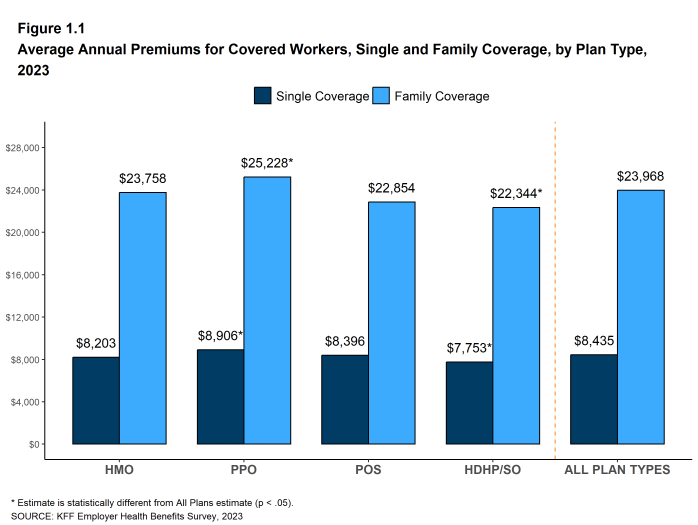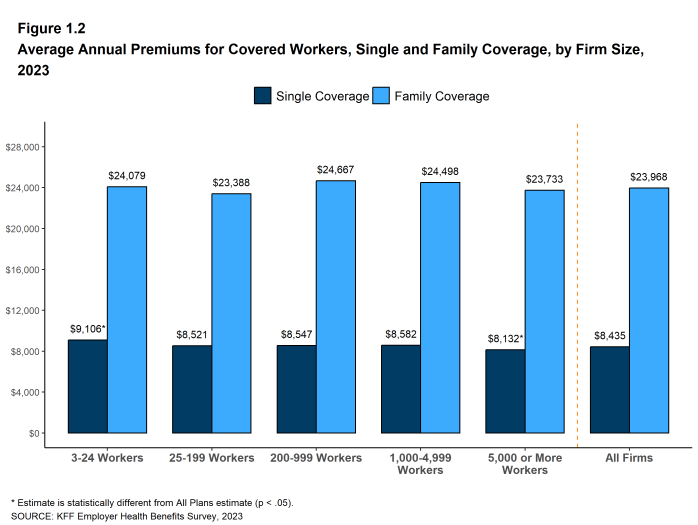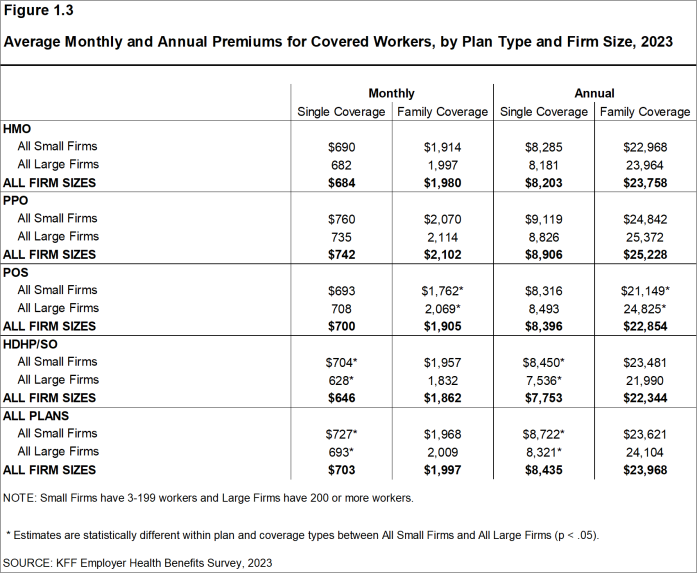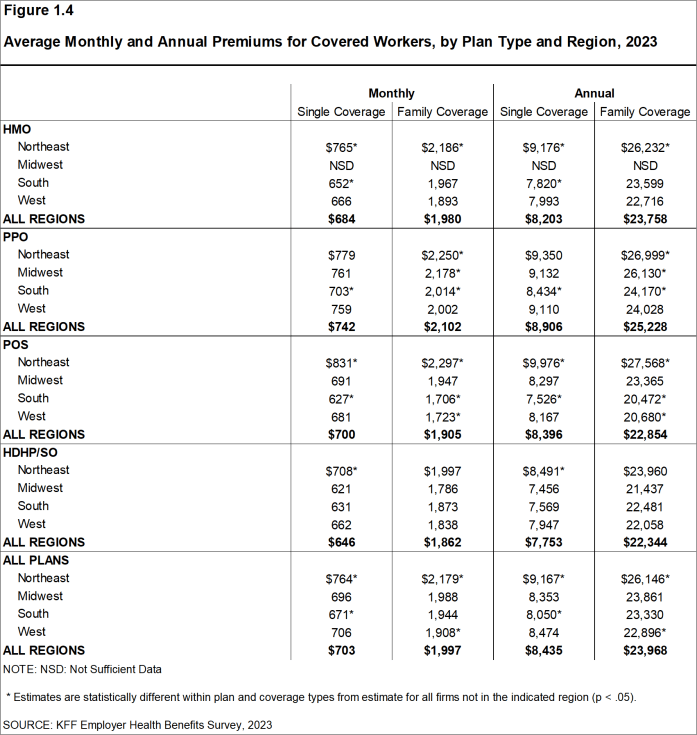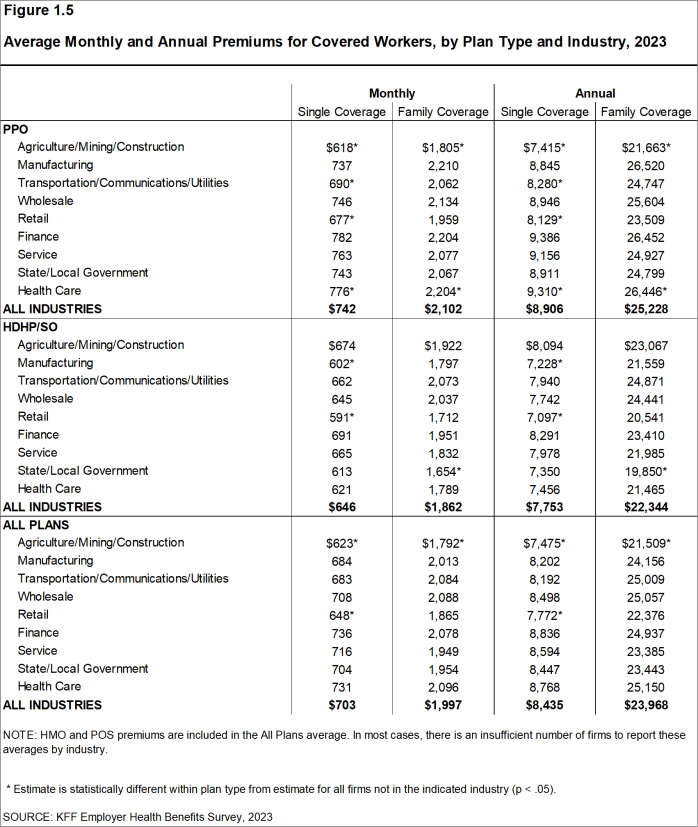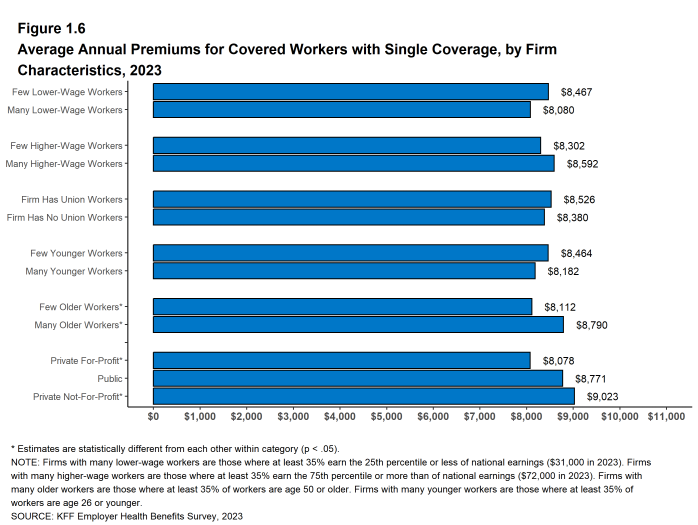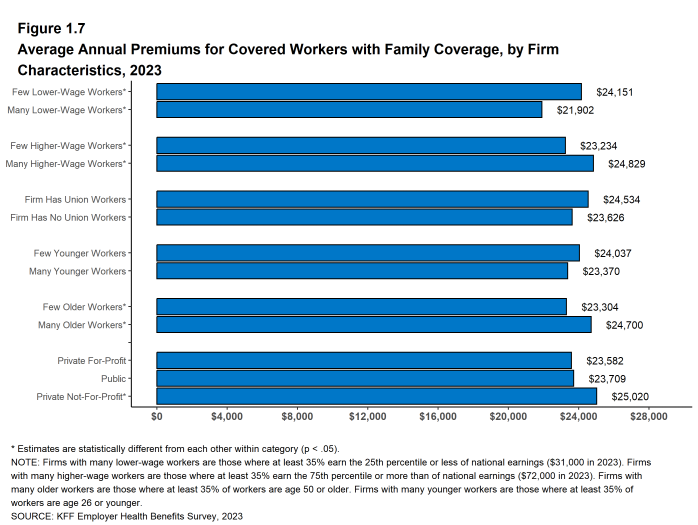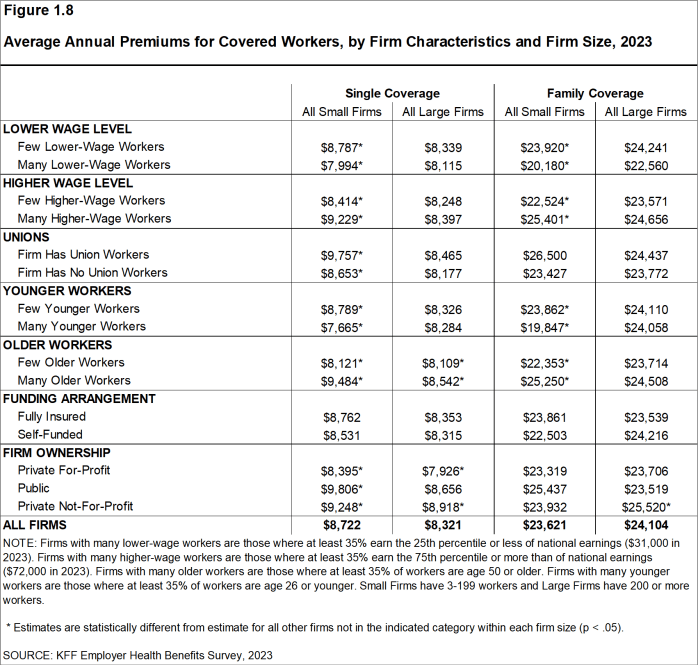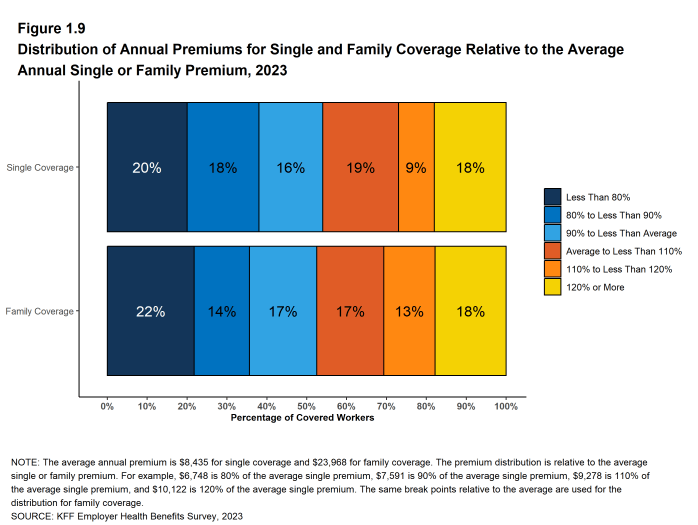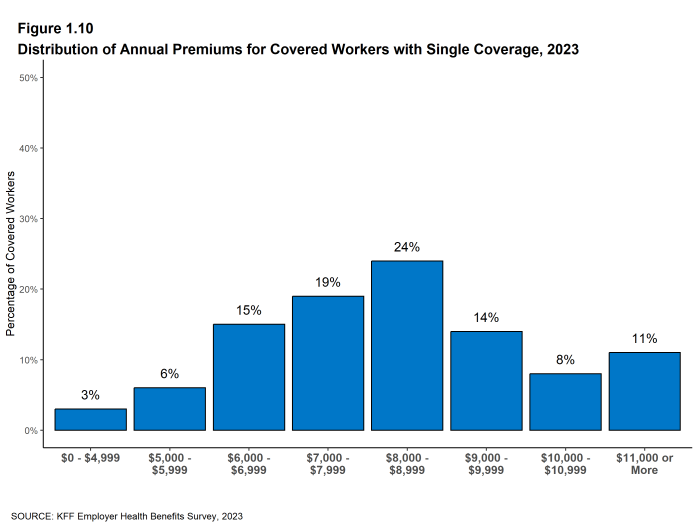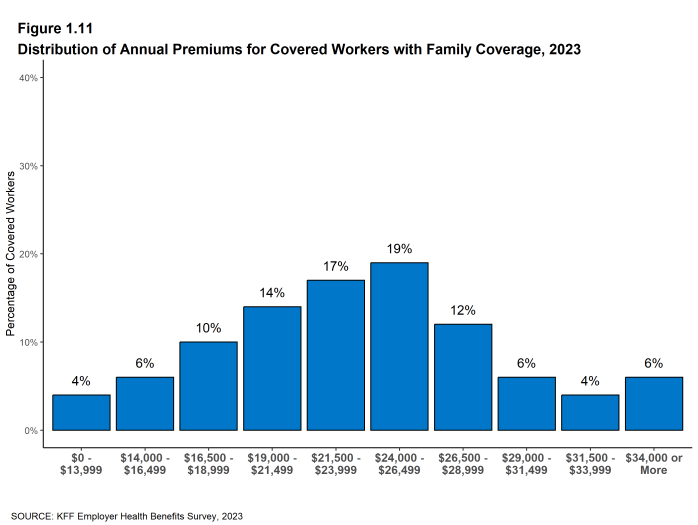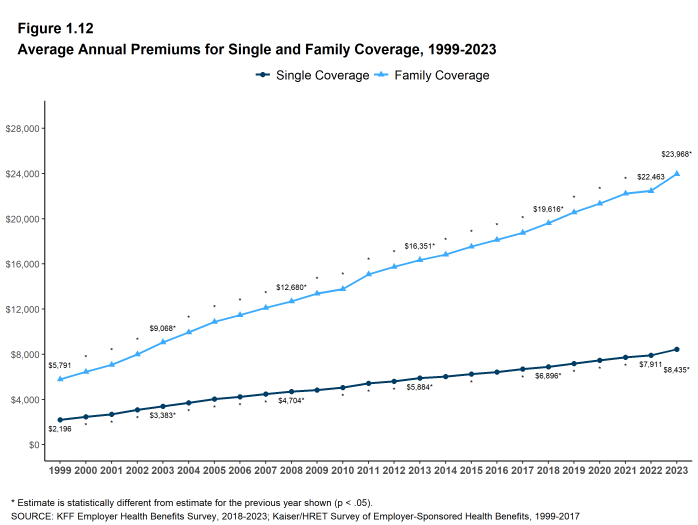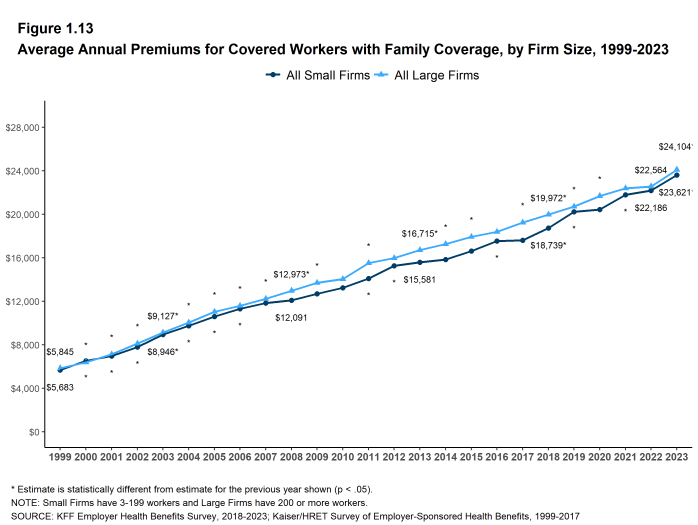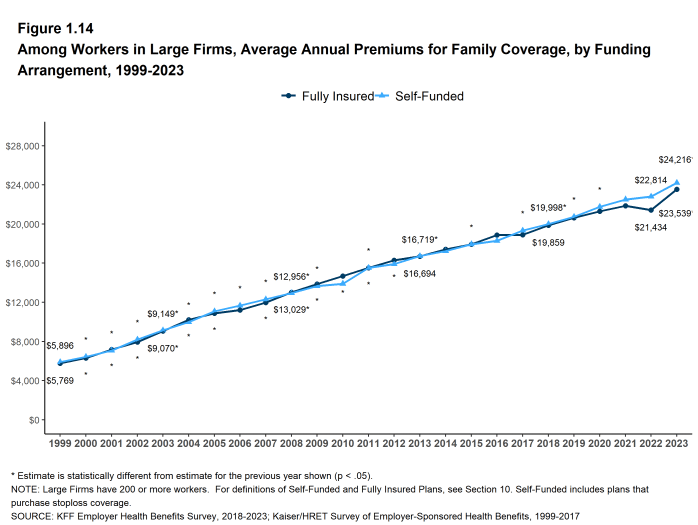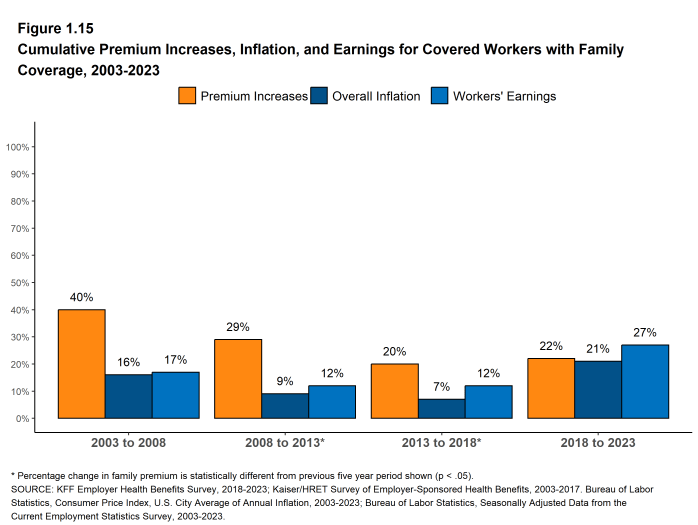2023 Employer Health Benefits Survey
Published:
Section 1: Cost of Health Insurance
Average annual health insurance premiums in 2023 are $8,435 for single coverage and $23,968 for family coverage. These average premiums each increased 7% in 2023. The average family premium has increased 22% since 2018 and 47% since 2013.
As part of this report, KFF publishes an online tool which allows users to look at changes in premiums and worker contributions for covered workers at different types of firms over time: https://www.kff.org/interactive/premiums-and-worker-contributions/
PREMIUMS FOR SINGLE AND FAMILY COVERAGE
- The average premium for single coverage in 2023 is $8,435 per year. The average premium for family coverage is $23,968 per year [Figure 1.1].
- The average annual premium for single coverage for covered workers at small firms ($8,722) is higher than the average premium for covered workers at large firms ($8,321). The average annual premium for family coverage for covered workers at small firms ($23,621) is similar to the average premium for covered workers at large firms ($24,104) [Figure 1.3].
- The average annual premiums for covered workers in HDHP/SOs are lower than the average premiums for coverage overall for both single coverage ($7,753 vs. $8,435) and family coverage ($22,344 vs. $23,968). The average premiums for covered workers in PPOs are higher than the overall average premiums for both single coverage ($8,906 vs. $8,435) and family coverage ($25,228 vs. $23,968) [Figure 1.1].
- The average premium for covered workers with single coverage is relatively higher in the Northeast and relatively lower in the South. The average premium for covered workers with family coverage is relatively higher in the Northeast and relatively lower in the West [Figure 1.4].
- The average family premium for covered workers at firms with a relatively large share of lower-wage workers (firms where at least 35% of the workers earn $31,000 annually or less) is lower than the average premium for covered workers at firms with smaller shares of lower-wage workers for family coverage ($21,902 vs. $24,151) [Figure 1.7].
- The average premiums for covered workers at firms with a relatively large share of older workers (firms where at least 35% of the workers are age 50 or older) are higher than the average premium for covered workers at firms with smaller shares of older workers for single coverage ($8,790 vs. $8,112) and for family coverage ($24,700 vs. $23,304) [Figure 1.6] and [Figure 1.7].
- The average premium for single coverage is relatively low for covered workers at private for-profit firms and relatively high for covered workers at private not-for profit firms. The average premium for family coverage is higher for covered workers at private not-for-profit firms than average annual premiums for covered workers at other types of firms [Figure 1.6] and [Figure 1.7].
Figure 1.1: Average Annual Premiums for Covered Workers, Single and Family Coverage, by Plan Type, 2023
Figure 1.2: Average Annual Premiums for Covered Workers, Single and Family Coverage, by Firm Size, 2023
Figure 1.3: Average Monthly and Annual Premiums for Covered Workers, by Plan Type and Firm Size, 2023
Figure 1.5: Average Monthly and Annual Premiums for Covered Workers, by Plan Type and Industry, 2023
Figure 1.6: Average Annual Premiums for Covered Workers With Single Coverage, by Firm Characteristics, 2023
Figure 1.7: Average Annual Premiums for Covered Workers With Family Coverage, by Firm Characteristics, 2023
PREMIUM DISTRIBUTION
- There is considerable variation in premiums for both single and family coverage.
- Eighteen percent of covered workers are employed at a firm where the single coverage premium is at least 20% higher than the average single premium, while 20% of covered workers are at firms with a single premium less than 80% of the average single premium [Figure 1.9].
- For family coverage, 18% of covered workers are employed at a firm with a family premium at least 20% higher than the average family premium, while 22% of covered workers are at firms with a family premium less than 80% of the average family premium [Figure 1.9].
- Nineteen percent of covered workers are at a firm with an average annual premium of at least $10,000 for single coverage [Figure 1.10]. Seventeen percent of covered workers are at a firm with an average annual premium of at least $29,000 for family coverage [Figure 1.11].
Figure 1.9: Distribution of Annual Premiums for Single and Family Coverage Relative to the Average Annual Single or Family Premium, 2023
PREMIUM CHANGES OVER TIME
- The average premiums for covered workers with single and family coverage are each 7% higher than the average premiums from last year [Figure 1.12].
- The average premium for single coverage has grown 22% since 2018, the same as the growth in the average premium for family coverage over the same period [Figure 1.12].
- The $23,968 average family premium in 2023 is 22% higher than the average family premium in 2018 and 47% higher than the average family premium in 2013. The 22% family premium growth in the past five years is similar to the 20% growth between 2013 and 2018 [Figure 1.15].
- The average family premiums for covered workers at small firms and at large firms have grown at similar rates since 2018 (26% at small firms and 21% at large firms). For small firms, the average family premium rose from $18,739 in 2018 to $23,621 in 2023. For large firms, the average family premium rose from $19,972 in 2018 to $24,104 in 2023 [Figure 1.13].
- The average family premiums have grown at similar rates since 2013 for covered workers at small firms and at large firms (52% at small firms and 44% at large firms). At small firms, the average family premium rose from $15,581 in 2013 to $23,621 in 2023. In large firms, the average family premium rose from $16,715 in 2013 to $24,104 in 2023 [Figure 1.13].
- Over the past five years, the average family premium for covered workers at large firms that are fully insured has grown at a similar rate to the average family premium for covered workers in fully or partially self-funded firms (19% for fully insured plans and 21% for self-funded firms) [Figure 1.14].
- The average family premium grew 7% in 2023, similar to the inflation rate (5.8%). Over the last 5 years, family premiums grew 22%, also similar to the rate of inflation during this period (21%). Over the last ten years, the growth in the average premium for family coverage far outpaced inflation (47% vs. 30%) [Figure 1.15].
- The average family premium grew 7% in 2023, compared to the average wage growth rate of 5.2%. Over the last 5 years, family premiums grew 22%, compared to 27% wage growth. Over the last ten years, the average family premium and average wages grew at roughly comparable rates (47% vs. 42%) [Figure 1.15].
Figure 1.13: Average Annual Premiums for Covered Workers With Family Coverage, by Firm Size, 1999-2023
Figure 1.14: Among Workers in Large Firms, Average Annual Premiums for Family Coverage, by Funding Arrangement, 1999-2023
Sections
- Section 1: Cost of Health Insurance
- Section 2: Health Benefits Offer Rates
- Section 3: Employee Coverage, Eligibility, and Participation
- Section 4: Types of Plans Offered
- Section 5: Market Shares of Health Plans
- Section 6: Worker and Employer Contributions for Premiums
- Section 7: Employee Cost Sharing
- Section 8: High-Deductible Health Plans with Savings Option
- Section 9: Prescription Drug Benefits
- Section 10: Plan Funding
- Section 11: Retiree Health Benefits
- Section 12: Health Screening and Health Promotion and Wellness Programs and Disease Management
- Section 13: Employer Practices, Telehealth, Provider Networks, Coverage Limits and Coverage for Abortion

